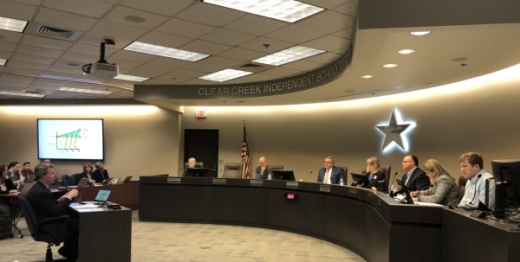Clear Creek ISD’s board of trustees reviewed a draft of the 2020-25 strategic plan, which Superintendent Greg Smith referred to as the district’s “road map for 2025 and beyond,” with district leadership at a March 2 workshop.
The workshop was the first time all board members had seen the plan in its entirety. Steven Ebell, deputy superintendent of curriculum and instruction, discussed with members how the district can use this plan to build on its past efforts and establish a new identity. Strategic planning is conducted campus- and districtwide, Ebell said.
A group of 30 district administrators, campus-level staff, board members and other officials met for planning sessions over several days in mid-July. Action team volunteers were recruited in December, with the end result being 156 people across five teams. Each team dealt with a different strategy, and the five strategies are the crux of the strategic plan.
“The intent there is to include action plans that speak to that,” Ebell said in response.
One strategy includes implementing trauma-informed professional learning across campuses, as well as providing a safety and cybersecurity curriculum for students, staff, parents and community members. Another addresses student achievement, while a third addresses student, staff and parent education and enrichment to support social and emotional learning. Ebell pointed to the district’s The Leader in Me character education program as an example of programming that supports social learning, and he said the goal is to keep expanding that program.
Trustees Win Weber and Jennifer Broddle said it is the district’s responsibility to provide for all students, including any in need of extra guidance.
“Just remember those kids who might need a little coaxing for whatever reason,” Weber said.
Broddle, who served on one of the action teams, asked Ebell about tools and skills related to anxiety management, adding that anxiety “drives every decision students are making.” Ebell said these tools are included in the plan.
Another aspect of the plan includes a shift in disciplinary measures to move toward restorative rather than punitive practices. The new focus ensures students can maintain attendance as much as possible, Ebell said. This might mean a student receives mandated after-school community service hours instead of in-school suspension, for example, he added.
Reform to the district’s special education program falls under the second and fifth strategies, Ebell said. These teams discussed how to deepen available opportunities and provide equal access. The fifth strategy explicitly identifies increased inclusivity as an action point. The strategic planning process is about halfway complete, Ebell said at the meeting. An implementation schedule will be presented in the coming weeks. The plan will be brought back to the board at the end of the month for approval, Smith said.
The strategic plan will be reviewed annually. District and campus strategic plans will be implemented during the summer, and by August, CCISD will be "fully aligned" to move forward with the plan, Ebell said.
Broddle expressed satisfaction with the scope of the drafted plan, even despite some of the finer details that cannot be seen in a condensed version.
“There’s a good bit that’s lost in boiling everything down, especially in words and thoughts and specifics that we talked about,” she said. “It truly is multiple steps further than we’ve been doing it, but it’s hard to reflect that in five sentences under each action item.”
President Laura DuPont said the level of community input in this plan sets the district apart from others.
“It’s such a living document that has had input from so many members of our community,” she said. “This doesn’t happen everywhere; this isn’t just our plans—this is the community’s plans.”





